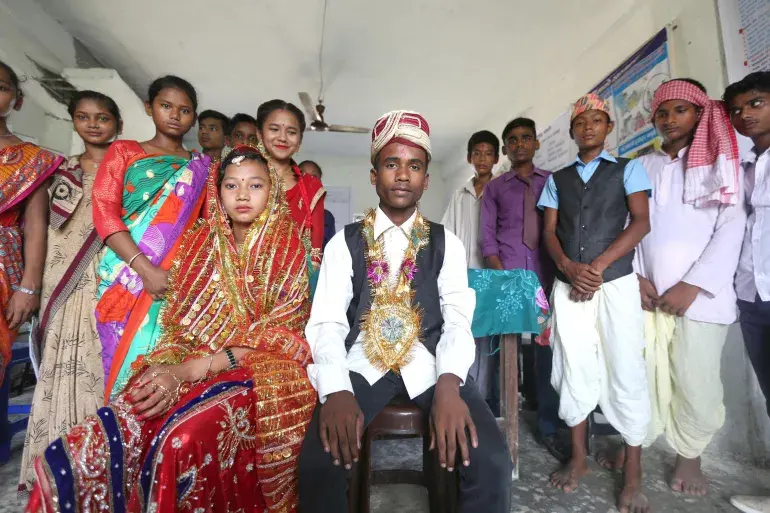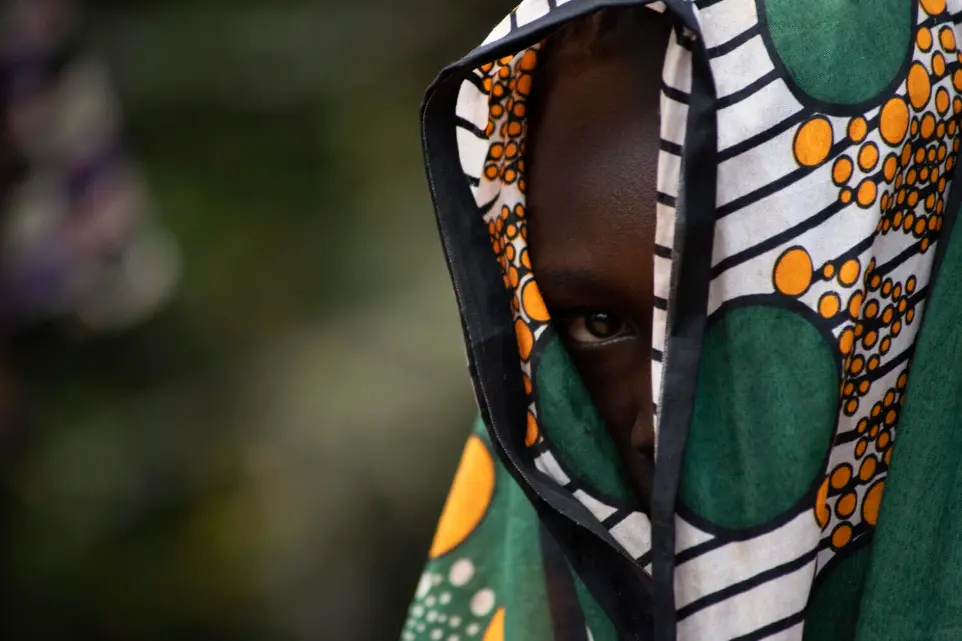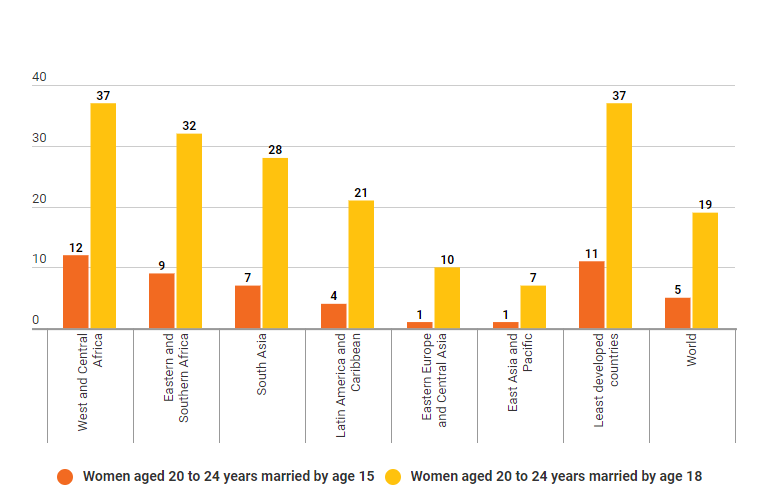Child marriage


Child marriage is a violation of human rights, but is all too common
Marriage before the age of 18 is a fundamental violation of human rights. Many factors interact to place a child at risk of marriage, including poverty, the perception that marriage will provide ‘protection’, family honor, social norms, customary or religious laws that condone the practice, an inadequate legislative framework and the state of a country’s civil registration system. While the practice is more common among girls than boys, it is a violation of rights regardless of sex.
Child marriage often compromises a girl’s development by resulting in early pregnancy and social isolation, interrupting her schooling, limiting her opportunities for career and vocational advancement and placing her at risk of domestic violence. Although the impact on child grooms has not been extensively studied, marriage may similarly place boys in an adult role for which they are unprepared, and may place economic pressures on them and curtail their opportunities for further education or career advancement.
Cohabitation – when a couple lives ‘in union’, as if married – raises the same human rights concerns as marriage. When a couple cohabitates, the assumption is often that they are adults, even if one or both has not yet reached the age of 18. Additional concerns due to the informality of the relationship – in terms of inheritance, citizenship and social recognition, for example – may make children in informal unions vulnerable in different ways than those who are formally married.
The issue of child marriage is addressed in a number of international conventions and agreements. The Convention on the Elimination of All Forms of Discrimination against Women, for example, covers the right to protection from child marriage in article 16, which states: “The betrothal and the marriage of a child shall have no legal effect, and all necessary action, including legislation, shall be taken to specify a minimum age for marriage….” The right to ‘free and full’ consent to marriage is recognized in the Universal Declaration of Human Rights, which says that consent cannot be ‘free and full’ when one of the parties involved is not sufficiently mature to make an informed decision about a life partner. Although marriage is not mentioned directly in the Convention on the Rights of the Child, child marriage is linked to other rights – such as the right to freedom of expression, the right to protection from all forms of abuse, and the right to be protected from harmful traditional practices – and is frequently addressed by the Committee on the Rights of the Child. Other international agreements related to child marriage are the Convention on Consent to Marriage, Minimum Age for Marriage and Registration of Marriages, the African Charter on the Rights and Welfare of the Child and the Protocol to the African Charter on Human and People’s Rights on the Rights of Women in Africa.
Child marriage among girls
Across the globe, levels of child marriage are highest in West and Central Africa, where nearly 4 in 10 young women were married before age 18. Lower levels of child marriage are found in Eastern and Southern Africa (32 per cent), South Asia (28 per cent), and Latin America and Caribbean (21 per cent).
Notes: Estimates are based on a subset of 101 countries covering 77 per cent of the population of women aged 20 to 24 . Regional estimates represent data covering at least 50 per cent of the regional population. Data coverage was insufficient to calculate regional estimates for the Middle East and North Africa, North America and Western Europe.

Child marriage among boys
While boys and girls who marry in childhood do not face the same risks and consequences due to biological and social differences, the practice is nonetheless a rights violation for children of both sexes. Similar to child brides, child grooms are forced to take on adult responsibilities for which they may not be prepared. The union may bring early fatherhood and result in additional economic pressure in the form of providing for the household; it may also constrain the boy’s access to education and opportunities for career advancement.

Globally, 115 million boys and men were married before age 18. The countries in which child marriage among boys is most common are geographically diverse and differ from the countries in which the practice is most common among girls.
While child grooms are less numerous than child brides, they similarly have experienced a rights violation that cuts short their childhood. Further research is needed on the drivers of the practice and its effect on child grooms.
115 million boys and men around the world married as children - UNICEF
First ever analysis on child grooms brings global child marriage figures to 765 million.
An estimated 115 million boys and men around the world were married as children, UNICEF said today in its first ever in-depth analysis of child grooms. Of these, 1 in 5 children, or 23 million, were married before the age of 15. Using data from 82 countries, the study reveals that child marriage among boys is prevalent across a range of countries around the world, spanning sub-Saharan Africa, Latin America and the Caribbean, South Asia, and East Asia and the Pacific.
“Marriage steals childhood,” said UNICEF Executive Director Henrietta Fore. “Child grooms are forced to take on adult responsibilities for which they may not be ready. Early marriage brings early fatherhood, and with it added pressure to provide for a family, cutting short education and job opportunities.”
According to the data, the Central African Republic has the highest prevalence of child marriage among males (28 per cent), followed by Nicaragua (19 per cent) and Madagascar (13 per cent).
The new estimates bring the total number of child brides and child grooms to 765 million. Girls remain disproportionately affected, with 1 in 5 young women aged 20 to 24 years old married before their 18th birthday, compared to 1 in 30 young men.
While the prevalence, causes and impact of child marriage among girls have been extensively studied, little research exists on child marriage among boys. However, children most at risk of child marriage come from the poorest households, live in rural areas, and have little to no education.
“As we mark the 30th anniversary of the adoption of the Convention on the Rights of the Child, we need to remember that marrying boys and girls off while they are still children runs counter to the rights enshrined in the Convention,” said Fore. “Through further research, investment and empowerment, we can end this violation.”

 IHRO NEWS
IHRO NEWS